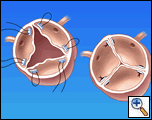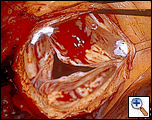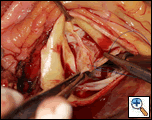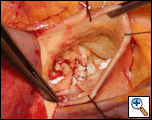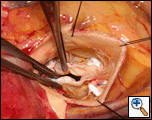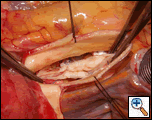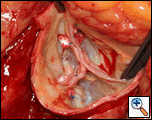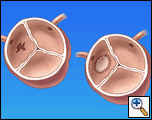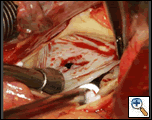Editor's Note
CTSNet seeks, through the Expert's Techniques Section, to provide information on the latest techniques in use by surgeons working at the forefront of the field. However, presentation on the web site should not be considered an endorsement of the techniques used. Unlike mitral valve repair, where the superiority and durability of the techniques over mechanical and bioprosthetic valves has clearly been demonstrated, the superior status of aortic valve repair has not yet been proven in comparision to the current generation of bioprosthetic valves. Drs. McKellar and Zehr are commended for their application of these techniques and they are presented here should they be useful to the practicing surgeon on an individual basis.
-Edward B. Savage, MD
Patient Selection
Aortic valve repair is nearly exclusively limited to patients with aortic regurgitation (AR) without a component of stenosis. Patients considered for repair are generally young who wish to avoid anticoagulation and would be expected to outlive a tissue valve should replacement be considered. In order to perform this operation, the cusps must be thin and flexible without calcifications. Most repairs result in downsizing the effective orifice area in order to increase coaptation with the available cusp area. There is a resultant increase in aortic valve gradient and this must be anticipated when evaluating patients preoperatively. The decision to repair an aortic valve is made by weighing the risk of repair failure versus the benefit of avoidance of oral anticoagulation therapy.
At Mayo Clinic, aortic valve repair is most commonly performed in patients with aortic regurgitation caused by
- a dilated aortic annulus
- conjoined cusp prolapse in bicuspid aortic valves (BAV)
- single cusp prolapse in tricuspid aortic valves, and
- aortic valve cusp perforation from endocarditis
Various techniques required for these regurgitant lesions are used to create competency in aortic valve with their geometry affected by type A aortic dissection, aortic root and ascending aortic aneurysms, and ventricular septal defects.
Aortic valve repair is performed in two general settings:
- patients who present with severe AR as their primary indication for surgery
- patients with another cardiac problem as the indication for surgery who are found to have concomitant AR.
Operative Steps
Approach
- A complete median sternotomy is performed.
- In patients requiring only aortic valve repair, a complete median sternotomy is performed through a limited 8 cm skin incision using an oscillating saw.
- After establishing cardiopulmonary bypass, a transverse aortotomy is performed 2 cm above the sinotubular junction. For better visualization, the aorta can be completely transected and suspended with stay sutures positioned above the commissures to better visualize the anatomy.
Cardiopulmonary Bypass
- Cardiopulmonary bypass is established with a distal ascending aorta arterial cannula and a double-stage venous cannula via the right atrium.
- The patient is kept normothermic.
- The left ventricle is vented via a right superior pulmonary vein approach.
- Cardioplegia is first administered retrograde via a coronary sinus catheter and subsequent antegrade cardioplegia can be administered directly into the coronary ostia via a soft ostial cannula.
Pathology-Specific Approach
Annular Dilation
- This type of AR is caused by a dilated aortic annulus resulting in a sagging of the belly of the cusp resulting in lack of central cusp apposition. Reduction annuloplasty corrects the problem by increasing the surface area of cusp coaptation.
- The subcommissural triangles are closed by horizontal mattress sutures (4-0 polypropylene) reinforced with teflon pledgets (Figure 1). Coaptation height increases more, the lower the sutures are placed. The valve orifice decreases more the lower the sutures are placed.
- Dilators can be used to assess the annulus diameter following commissural plication.
- The sinotubular junction is often slightly dilated in these patients. This splaying outwardly of the commissural posts contributes to central AR. Repair requires either plication above the commissures or circumferential downsizing of the sinotubular junction by replacing an enlarged ascending aorta with an appropriately sized Dacron tube graft. This tube graft diameter should be 10-15% smaller than the measured annular diameter.
Bicuspid Aortic Valve
- This type of AR results from the prolapse of the conjoint cusp. The usual conjoint cusp is a fusion of the right and left coronary cusps. The goal of the correction is to shorten the redundant conjoint cusp thus elevating the free margin of the cusp to coapt with the other non-prolapsing cusp.
- The redundant free margin in triangularly resected in the central fused raphe portion. The resection is not continued to the annulus. The apex of the triangle is ended midway to the annulus where the valve cusp tissue remains thickened.
- The cut edges of the cusp are reapproximated using 5-0 or 6-0 polypropylene suture in an interrupted fashion. (Figure 2).
- Often the raphe is tethered to the aortic wall by a residual commissure. This band of tissue can tether the conjoint cusp away from the center of the aortic orifice. The band should be cut releasing the central portion of the conjoint cusp and deepening the belly of the cusp. The cut to sever the tethering raphe band can be carried into the aortic wall to avoid perforating the thin portion of the cusp where it attaches to the adjacent annulus.
- Occasionally, the non-conjoint cusp requires slight shortening with a plication suture (6-0 polypropylene suture) to adjust it to the newly repaired conjoint cusp.
- The two subcommissural triangles are then closed as previously described.
Cusp Prolapse in Tricuspid Valve
- This type of AR is caused by the prolapse of one or more cusps. The free margin is elongated. This can occur by rupture of a small fenestration. The goal of this repair is to shorten the free margin to meet the other cusps.
- There are different ways to repair this defect:
- As described by Trusler, the prolapsed cusp can be plicated near the commissure with 5/0 polypropylene suture. Often the best place for the plication suture is not near the commissure where the free margin is very thin but next to the node of Arantis where the margin holds a suture better (Figure 3).
- The prolapsed cusp can be resuspended by performing a limited triangular resection in the center of the cusp with reapproximation of the cut edges of the cusp with interrupted 6-0 polypropylene sutures.
- The free edge can be shortened by weaving a 5-0 PTFE suture along the free edge of the cusp and anchoring it to the commissure.
The three subcommissural triangles are then closed as previously described.
Cusp Perforation
- This type of AR is caused by infective endocarditis or iatrogenic perforation. The goal of this repair is to patch the defect in the cusp.
- An autologous pericardial patch is prepared and used to cover the defect with either running or interrupted 6-0 polypropylene suture. (Figure 4). Avoid the urge to close this defect primarily. This results in retraction of the free margin and loss of coaptation.
Concluding Tips
Saline can be used to fill the cusps to estimate apposition of the cusps.
- The aortotomy is closed with a running 4-0 polypropylene suture over and over in a double layer with Teflon felt pledgets at both ends to buttress the suture line. In the case of complete transection of the aorta a continuous running 4-0 polypropylene suture is used. The cross clamp is removed. The heart is de-aired and the patient weaned from cardiopulmonary bypass.
- Intraoperative transesophageal echocardiography is used to assess the adequacy of the repair.
Discussion
Aortic valve repair has been described in the literature predominantly for the indications of dilated annulus, bicuspid aortic valve (BAV) and cusp prolapse of trileaflet valves [1, 5, 7]. While aortic valve repair for dilated annulus is the most accepted indication, some controversy exists about aortic valve repair for patients with BAV and cusp prolapse of trileaflet valves. This controversy stems from the concern for an increased need for reoperation in these patients.
The Toronto group reported a 26% reoperation rate at 5 years in theirs series of 54 adults with congenital heart disease both with and without BAV5. They concluded that presence of BAV did not increase the risk of reoperation.
Surgeons at the Cleveland Clinic reported a 13% reoperation rate in a series of BAV patients [7]. We reported our experience at Mayo Clinic in 160 consecutive patients with indications for valve repair including a dilated annulus, BAV and trileaflet valve cusp prolapse [1]. At 5 years, the reoperation rate was 11% overall and 10%, 9% and 16% for dilated annulus, BAV and trileaflet valve cusp prolapse respectively.
From these reports, the durability of aortic valve repair for varying indications is similar.
Preference Card
Aortic retractor set
Suture
- For annular dilation-
a. 4-0 polypropylene on an RB needle.
b. Teflon Pledgets. - For BAV-
a. 5-0 polypropylene on an RB needle.
b. Teflon Pledgets and 4-0 polypropylene on an RB needle. - For cusp prolapse of tricuspid aortic valve-
a. 5-0 PTFE suture on an RB needle. - For cusp perforation-
a. 6-0 polypropylene suture on an RB needle.
Tips and Pitfalls
- Go over the pre-sternotomy intraoperative transesophageal echocardiography images yourself with the echocardiologist. Learn to correlate the echo images with the anatomical appearance of the aortic root and valve.
- A full median sternotomy through a limited skin incision serves the same purpose as a partial sternotomy but has the advantage of providing better exposure and is able to be kept more inferior to the sternal notch and thus less obtrusive.
- Remember to transect the aorta and suspend the root symmetrically to most easily assess the valve in anticipation of repair.
- Examine all the cusps carefully not just the prolapsing one. It is disheartening to perform a nice cusp resuspension only to find several large fenestrations on the other cusps which are likely to effect durability of the valve.
- Bicuspid valves with moderate calcium have limited durability particularly if made even smaller with a repair. They should probably be replaced.
- Plication sutures of the free margin of the cusp should be placed in the thickest portion of the free margin but not in the node of Arantis. This place is usually just adjacent to the node of Arantis.
- Do not hesitate to adjust the free margin of a cusp to coapt better with the primarily repaired cusp.
- The real test of valve competence after repair happens with the release of the cross-clamp. Regurgitation can be assessed by left ventricular distension, left ventricular vent return, and an ejection wave on the monitor.
- Residual prolapse will result in early reoperation.
References
- Minikata, et al. Is repair of aortic valve regurgitation a safe alternative to valve replacement? J Thorac Cardiovasc Surg 2004;127:645-53.
- Trusler, et al. Late results after repair of aortic insufficiency associated with ventricular septal defect. J Thorac Cardiovasc Surg 1992;103:276-81.
- Carpentier A. Cardiac valve surgery-the “French correction.” J Thorac Cardiovasc Surg 1983;86:323-37.
- Cosgrove, et al. Valvuloplasty for aortic insufficiency. J Thorac Cardiovasc Surg 1991;102:571-6.
- Rao, et al. Aortic valve repair for adult congenital heart disease : a 22-year experience. Circulation 2000;102(Supp III):III40-3.
- Fraser, et al. Repair of bicuspid aortic valves. Ann Thorac Surg 1994;58:386-90.
- Casselman FP, et al. Intermediate-term durability of bicuspid aortic valve repair for prolapsing leaflet. Eur J Cardio-Thorac Surg 1999;15:302-308.
